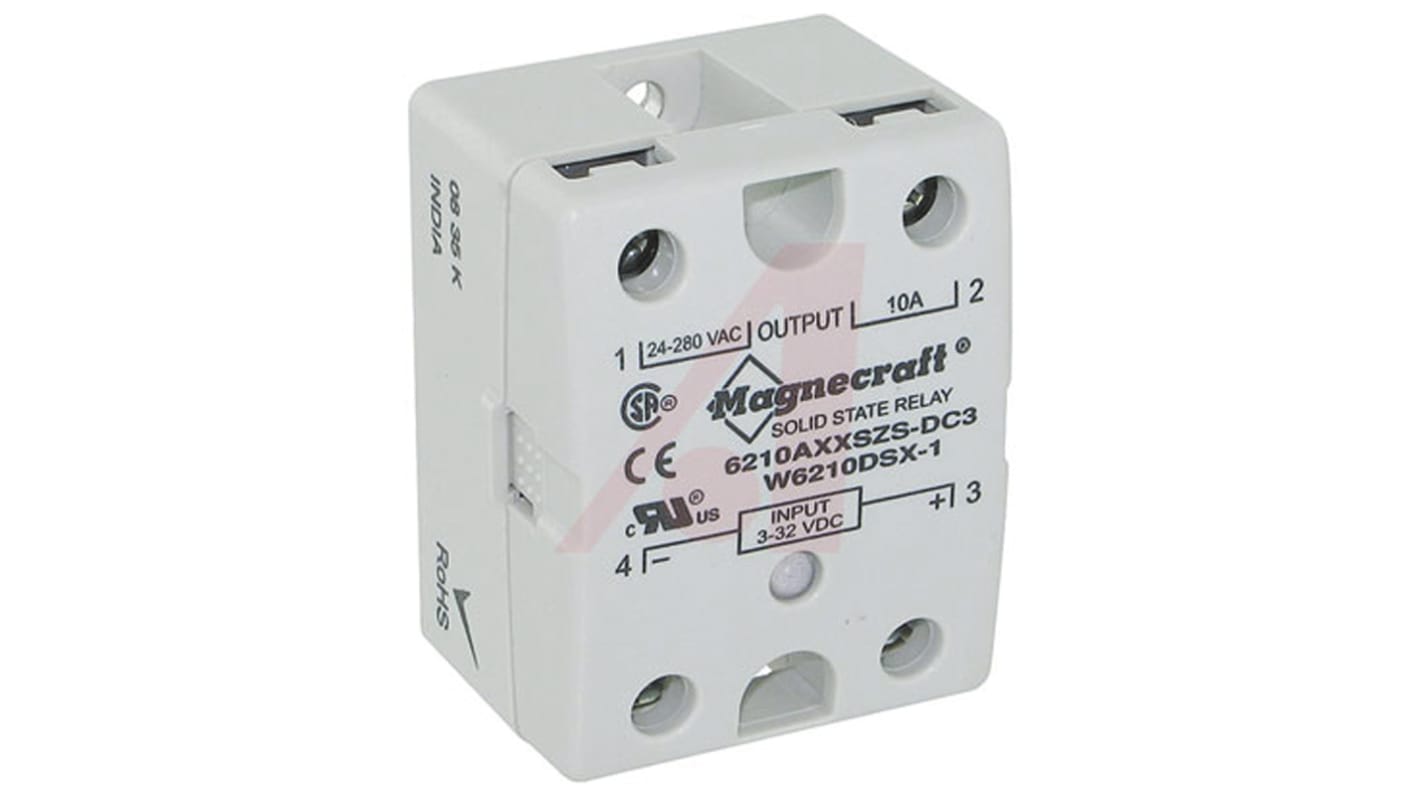Schneider Electric Solid State Relay, 10 A Load, Panel Mount, 280 V ac Load, 32 V dc Control
- RS Stock No.:
- 827-8642
- Mfr. Part No.:
- 6210AXXSZS-DC3
- Brand:
- Schneider Electric

Subtotal (1 unit)*
£53.47
(exc. VAT)
£64.16
(inc. VAT)
FREE delivery for orders over £50.00
- 26 left, ready to ship
- Final 30 unit(s) shipping from 01 January 2026
Units | Per unit |
|---|---|
| 1 + | £53.47 |
*price indicative
- RS Stock No.:
- 827-8642
- Mfr. Part No.:
- 6210AXXSZS-DC3
- Brand:
- Schneider Electric
Select all | Attribute | Value |
|---|---|---|
| Brand | Schneider Electric | |
| Maximum Load Current | 10 A | |
| Mounting Type | Panel Mount | |
| Maximum Load Voltage | 280 V ac | |
| Minimum Load Voltage | 24 V ac | |
| Minimum Control Voltage | 3 V dc | |
| Maximum Control Voltage | 32 V dc | |
| Switching Type | Zero Cross | |
| Control Voltage Range | 3 → 32 V dc | |
| Minimum Load Current | 50 mA | |
| Range | Legacy | |
| Terminal Type | Screw | |
| Contact Configuration | SPST | |
| Output Device | SCR | |
| Maximum Turn On Time | 8.3ms | |
| Load Voltage Range | 24 → 280V ac | |
| Dimensions | 57.91 x 44.14 x 35.9mm | |
| Depth | 44.1mm | |
| Length | 57.2mm | |
| Minimum Operating Temperature | -40°C | |
| Maximum Operating Temperature | +80°C | |
| Off State Leakage Current | 10 mA | |
| Height | 35.9mm | |
| Operating Temperature Range | -40 → +80°C | |
| Standards Met | CE, CSA, UL | |
| Select all | ||
|---|---|---|
Brand Schneider Electric | ||
Maximum Load Current 10 A | ||
Mounting Type Panel Mount | ||
Maximum Load Voltage 280 V ac | ||
Minimum Load Voltage 24 V ac | ||
Minimum Control Voltage 3 V dc | ||
Maximum Control Voltage 32 V dc | ||
Switching Type Zero Cross | ||
Control Voltage Range 3 → 32 V dc | ||
Minimum Load Current 50 mA | ||
Range Legacy | ||
Terminal Type Screw | ||
Contact Configuration SPST | ||
Output Device SCR | ||
Maximum Turn On Time 8.3ms | ||
Load Voltage Range 24 → 280V ac | ||
Dimensions 57.91 x 44.14 x 35.9mm | ||
Depth 44.1mm | ||
Length 57.2mm | ||
Minimum Operating Temperature -40°C | ||
Maximum Operating Temperature +80°C | ||
Off State Leakage Current 10 mA | ||
Height 35.9mm | ||
Operating Temperature Range -40 → +80°C | ||
Standards Met CE, CSA, UL | ||
RoHS Status: Exempt
Schneider Electric Solid-State Relay, 24 to 280V AC Output Voltage, 8.3ms Response Time - 6000 Series - 6210AXXSZS-DC3
• IP20 rating indicates it's finger-safe for protection against electric shocks
• Designed for panel mounting for ease of installation in control cabinets
Applications
• Medical technology
• Robotics
What's the difference between a solid-state relay and an electromechanical relay?
Note
Related links
- Schneider Electric Solid State Relay PCB Mount 72 V dc Control
- Schneider Electric Solid State Relay PCB Mount 30 V dc Control
- Schneider Electric Solid State Relay Panel Mount 32 V dc Control
- Schneider Electric Solid State Relay Panel Mount 32 V dc Control
- Schneider Electric Solid State Relay DIN Rail Mount 32 V dc Control
- Schneider Electric Solid State Relay DIN Rail Mount 280 V ac Control
- Schneider Electric SSM Series Solid State Relay DIN Rail Mount 32 V dc Control
- Schneider Electric Harmony Relay Series Solid State Relay DIN Rail Mount 32 V dc Control
